Field Radiometric Calibration of a Micro-Spectrometer Based on Remote Sensing of Plateau Inland Water Colors
Abstract
:1. Introduction
2. Data and Methods
2.1. Equipment and Methods
2.2. Data Processing and Evaluation Metrics
3. Results
3.1. Effect of Integration Time on Spectral Acquisition of Water
3.2. Comparison of Gain and Offset Via Two Fiber Types
3.3. Comparison of Radiance/Irradiance Measured in Four Diffuse Reflector/Target Cloths
4. Discussion
4.1. Comparison of Rrs Measured in Two Plateau Inland Water Body Types
4.2. Unmanned Area Applications
5. Conclusions
Author Contributions
Funding
Institutional Review Board Statement
Informed Consent Statement
Data Availability Statement
Acknowledgments
Conflicts of Interest
Appendix A

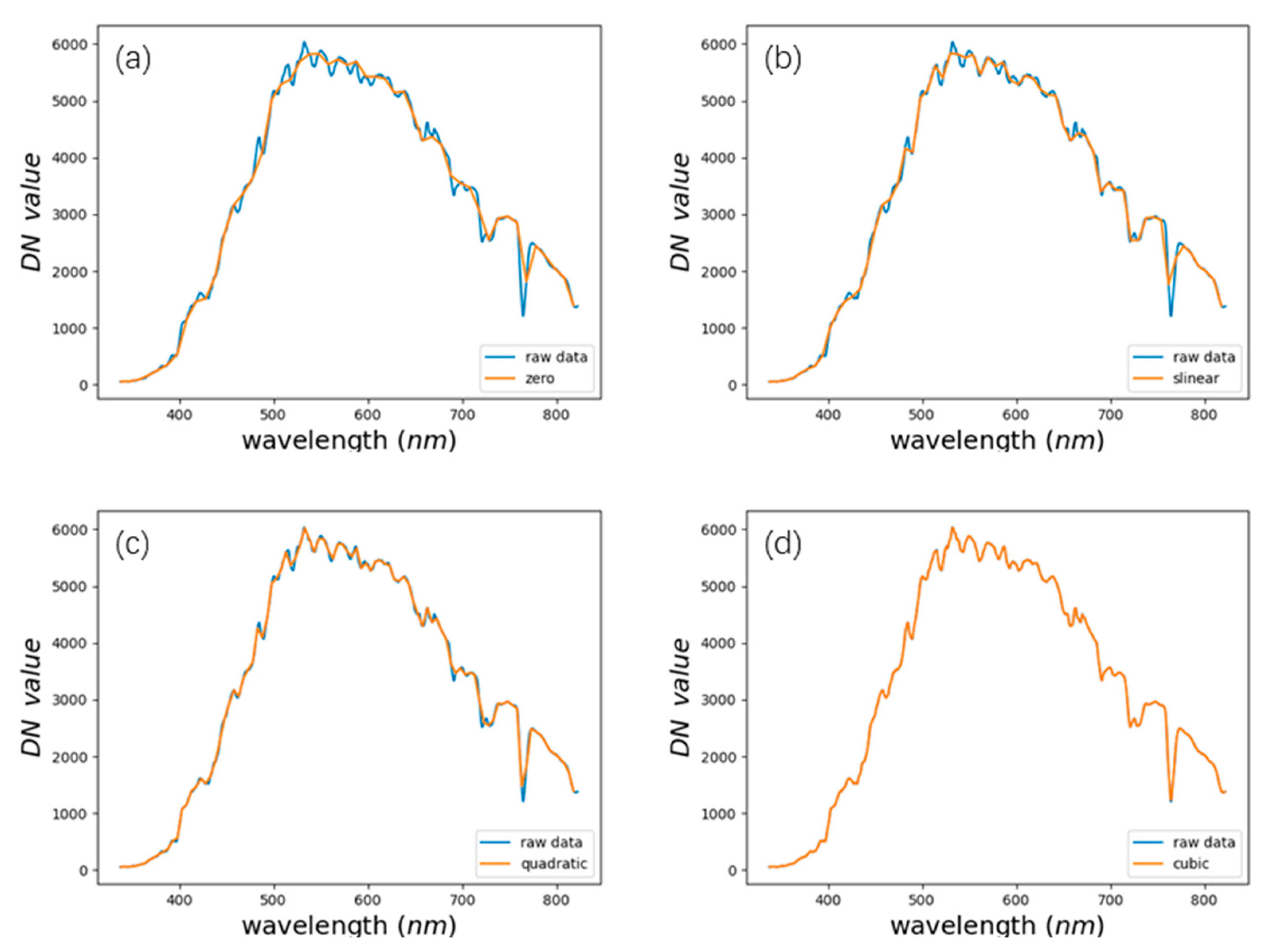
References
- Antoine, D.; IOCCG. Ocean-Colour Observations from a Geostationary Orbit; International Ocean Colour Coordinating Group (IOCCG): Dartmouth, NS, Canada, 2012. [Google Scholar]
- Chawla, I.; Karthikeyan, L.; Mishra, A.K. A Review of Remote Sensing Applications for Water Security: Quantity, Quality, and Extremes. J. Hydrol. 2020, 585, 124826. [Google Scholar] [CrossRef]
- Hou, X.; Feng, L.; Dai, Y.; Hu, C.; Gibson, L.; Tang, J.; Lee, Z.; Wang, Y.; Cai, X.; Liu, J.; et al. Global Mapping Reveals Increase in Lacustrine Algal Blooms over the Past Decade. Nat. Geosci. 2022, 15, 130–134. [Google Scholar] [CrossRef]
- Shen, Q.; Yao, Y.; Li, J.; Zhang, F.; Wang, S.; Wu, Y.; Ye, H.; Zhang, B. A CIE Color Purity Algorithm to Detect Black and Odorous Water in Urban Rivers Using High-Resolution Multispectral Remote Sensing Images. IEEE Trans. Geosci. Remote Sens. 2019, 57, 6577–6590. [Google Scholar] [CrossRef]
- O’Reilly, J.; Maritorena, S.; Mitchell, B.; Siegel, D.; Carder, K.; Garver, S.; Kahru, M.; McClain, C. Ocean Color Chlorophyll Algorithms for SEAWIFS. J. Geophys. Res. 1998, 103, 24937–24953. [Google Scholar] [CrossRef]
- Ni, Z.; Wang, S.; Wang, Y. Characteristics of Bioavailable Organic Phosphorus in Sediment and Its Contribution to Lake Eutrophication in China. Environ. Pollut. 2016, 219, 537–544. [Google Scholar] [CrossRef]
- Chen, Z.; Hu, C.; Comny, R.N.; Muller-Karger, F.; Swarzenski, P. Colored Dissolved Organic Matter in Tampa Bay, Florida. Mar. Chem. 2007, 104, 98–109. [Google Scholar] [CrossRef]
- Liu, D.; Yu, S.; Xiao, Q.; Qi, T.; Duan, H. Satellite Estimation of Dissolved Organic Carbon in Eutrophic Lake Taihu, China. Remote Sens. Environ. 2021, 264, 112572. [Google Scholar] [CrossRef]
- Federico, B.; Marco, C.; Jixi, G.; Robert, H.; Massimo, M.; Yanming, R.; Patrizia, S.; Luigi, T. Remote Sensing Methodology for the Estimation of Methane Emissions from Chinese Lakes. In Proceedings of the 2008 International Workshop on Earth Observation and Remote Sensing Applications, Beijing, China, 30 June–2 July 2008; IEEE: Piscataway, NJ, USA, 2018; pp. 1–6. [Google Scholar]
- The Analytical Spectral Devices, FieldSpec. Available online: https://www.malvernpanalytical.com/en/products/product-range/asd-range/fieldspec-range (accessed on 9 August 2022).
- High-Resolution Profiling Reflectance Radiometer (PRR). Available online: http://www.biospherical.com/index.php?option=com_content&view=article&id=51&Itemid=67 (accessed on 9 August 2022).
- GmbH, T. RAMSES. Available online: https://www.trios.de/en/ramses.html (accessed on 9 August 2022).
- Hyperspectral Surface Acquisition System Sea-Bird Scientific. Available online: https://www.seabird.com/hyperspectral-surface-acquisition-system/product?id=54627923900&callback=qs (accessed on 9 August 2022).
- Yang, Z.; Albrow-Owen, T.; Cai, W.; Hasan, T. Miniaturization of Optical Spectrometers. Science 2021, 371, 0722. [Google Scholar] [CrossRef]
- Zarzar, C.M.; Dash, P.; Dyer, J.L.; Moorhead, R.; Hathcock, L. Development of a Simplified Radiometric Calibration Framework for Water-Based and Rapid Deployment Unmanned Aerial System (UAS) Operations. Drones 2020, 4, 17. [Google Scholar] [CrossRef]
- Cao, H.; Gu, X.; Wei, X.; Yu, T.; Zhang, H. Lookup Table Approach for Radiometric Calibration of Miniaturized Multispectral Camera Mounted on an Unmanned Aerial Vehicle. Remote Sens. 2020, 12, 4012. [Google Scholar] [CrossRef]
- Shi, G.; Du, X.; Du, M.; Li, Q.; Tian, X.; Ren, Y.; Zhang, Y.; Wang, H. Cotton Yield Estimation Using the Remotely Sensed Cotton Boll Index from UAV Images. Drones 2022, 6, 254. [Google Scholar] [CrossRef]
- Gege, P.; Dekker, A.G. Spectral and Radiometric Measurement Requirements for Inland, Coastal and Reef Waters. Remote Sens. 2020, 12, 2247. [Google Scholar] [CrossRef]
- Cao, Z.; Ma, R.; Liu, J.; Ding, J. Improved Radiometric and Spatial Capabilities of the Coastal Zone Imager Onboard Chinese HY-1C Satellite for Inland Lakes. IEEE Geosci. Remote Sens. Lett. 2021, 18, 193–197. [Google Scholar] [CrossRef]
- Leroy, M.; Henry, P.; Guenther, B.; McLean, J. Comparison of CNES Spherical and NASA Hemispherical Large Aperture Integration Sources: II. Using the SPOT-2 Satellite Instruments. Remote Sens. Environ. 1990, 31, 97–104. [Google Scholar] [CrossRef]
- Shi, J.; Li, M.; Hu, Y.; Wang, X.; Xu, H.; Chi, G.; Hong, J. Laboratory Calibration of an Ultraviolet–Visible Imaging Spectropolarimeter. Remote Sens. 2022, 14, 3898. [Google Scholar] [CrossRef]
- Sun, Y.C.; Huang, C.; Xia, G.; Jin, S.Q.; Lu, H.B. Accurate Wavelength Calibration Method for Compact CCD Spectrometer. J. Opt. Soc. Am. A Opt. Image Sci. Vis. 2017, 34, 498–505. [Google Scholar] [CrossRef]
- Xiong, X.; Erives, H.; Xiong, S.; Xie, X.; Esposito, J.; Sun, J. Performance of Terra MODIS Solar Diffuser and Solar Diffuser Stability Monitor. In Proceedings of the Optics and Photonics 2005, San Diego, CA, USA, 31 July–4 August 2005; pp. 58820S.1–58820S.10. [Google Scholar]
- Xiong, X.; Barnes, W. An Overview of MODIS Radiometric Calibration and Characterization. Adv. Atmos. Sci. 2006, 23, 69–79. [Google Scholar] [CrossRef]
- Adão, T.; Hruška, J.; Pádua, L.; Bessa, J.; Peres, E.; Morais, R.; Sousa, J.J. Hyperspectral Imaging: A Review on UAV-Based Sensors, Data Processing and Applications for Agriculture and Forestry. Remote Sens. 2017, 9, 1110. [Google Scholar] [CrossRef]
- Smith, R.C.; Booth, C.R.; Star, J.L. Oceanographic Biooptical Profiling System. Appl. Opt. 1984, 23, 2791–2797. [Google Scholar] [CrossRef]
- Mueller, J.L. Above-Water Radiance and Remote Sensing Reflectance Measurement and Analysis Protocols. In Ocean Optics Protocols for Satellite Ocean Color Sensor Validation Revision 3; NASA Goddard Space Flight Center: Greenbelt, MD, USA, 2000; Volume 2, pp. 171–181. [Google Scholar]
- Lee, Z.; Pahlevan, N.; Ahn, Y.-H.; Greb, S.; O’Donnell, D. Robust Approach to Directly Measuring Water-Leaving Radiance in the Field. Appl. Opt. 2013, 52, 1693–1701. [Google Scholar] [CrossRef]
- Mobley, C.D. Estimation of the Remote-Sensing Reflectance from above-Surface Measurements. Appl. Opt. 1999, 38, 7442–7455. [Google Scholar] [CrossRef]
- Huang, C.; Zhang, L.; Fang, J.; Tong, Q. A Radiometric Calibration Model for the Field Imaging Spectrometer System. IEEE Trans. Geosci. Remote Sens. 2013, 51, 2465–2475. [Google Scholar] [CrossRef]
- Hu, C.; Feng, L.; Lee, Z.; Davis, C.O.; Mannino, A.; McClain, C.R.; Franz, B.A. Dynamic Range and Sensitivity Requirements of Satellite Ocean Color Sensors: Learning from the Past. Appl. Opt. 2012, 51, 6045–6062. [Google Scholar] [CrossRef]
- Cao, Z.; Ma, R.; Duan, H.; Xue, K. Effects of Broad Bandwidth on the Remote Sensing of Inland Waters: Implications for High Spatial Resolution Satellite Data Applications. ISPRS J. Photogramm. Remote Sens. 2019, 153, 110–122. [Google Scholar] [CrossRef]
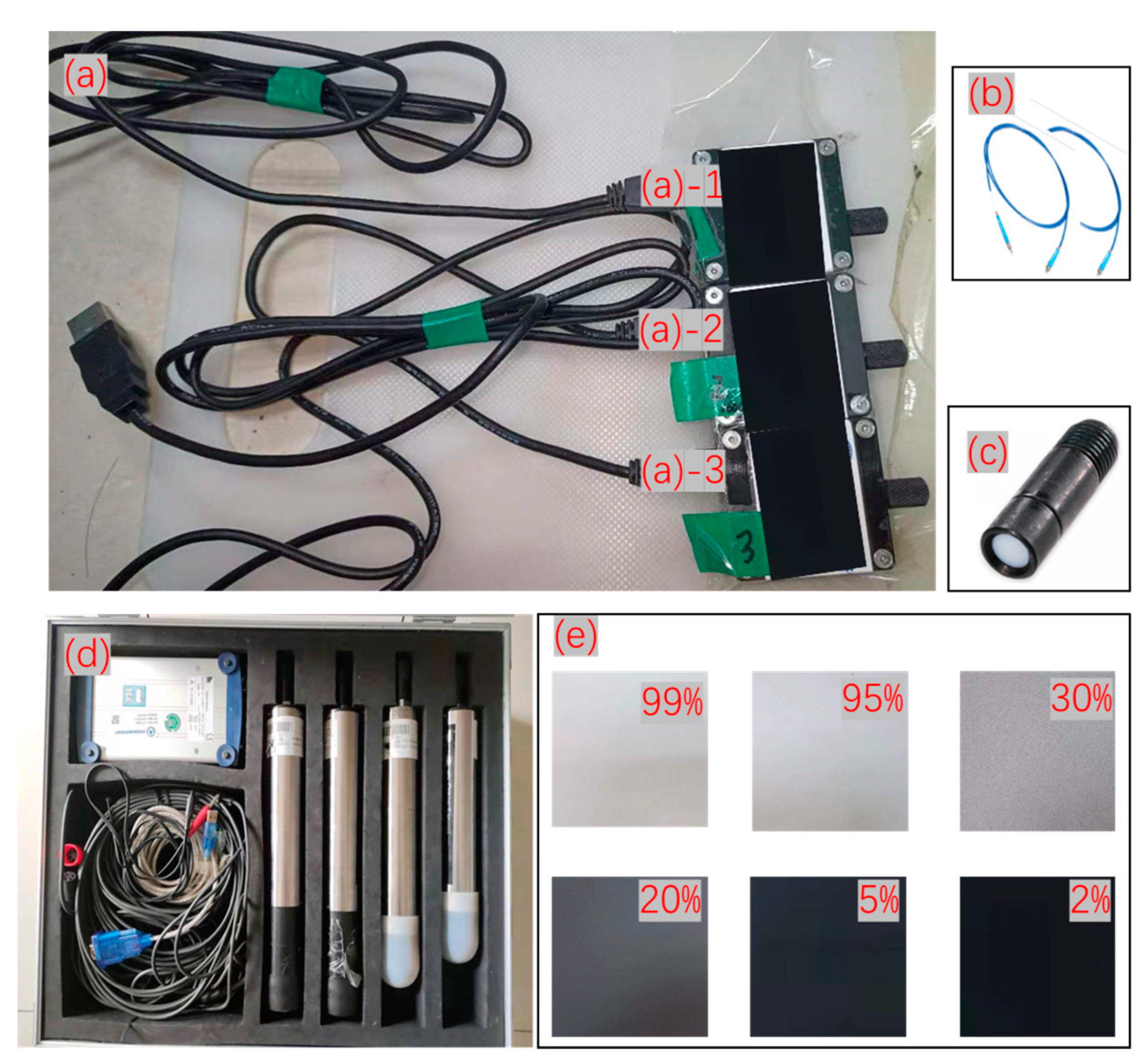

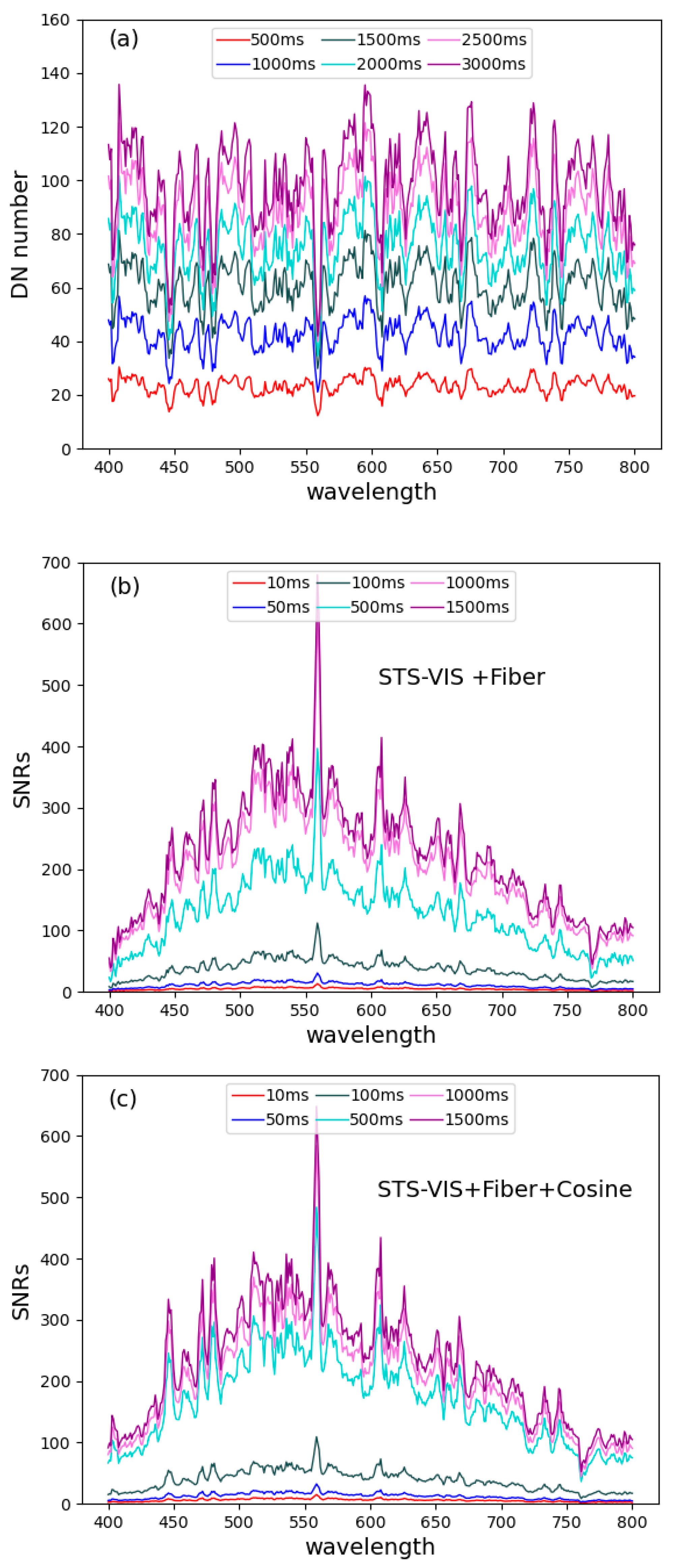
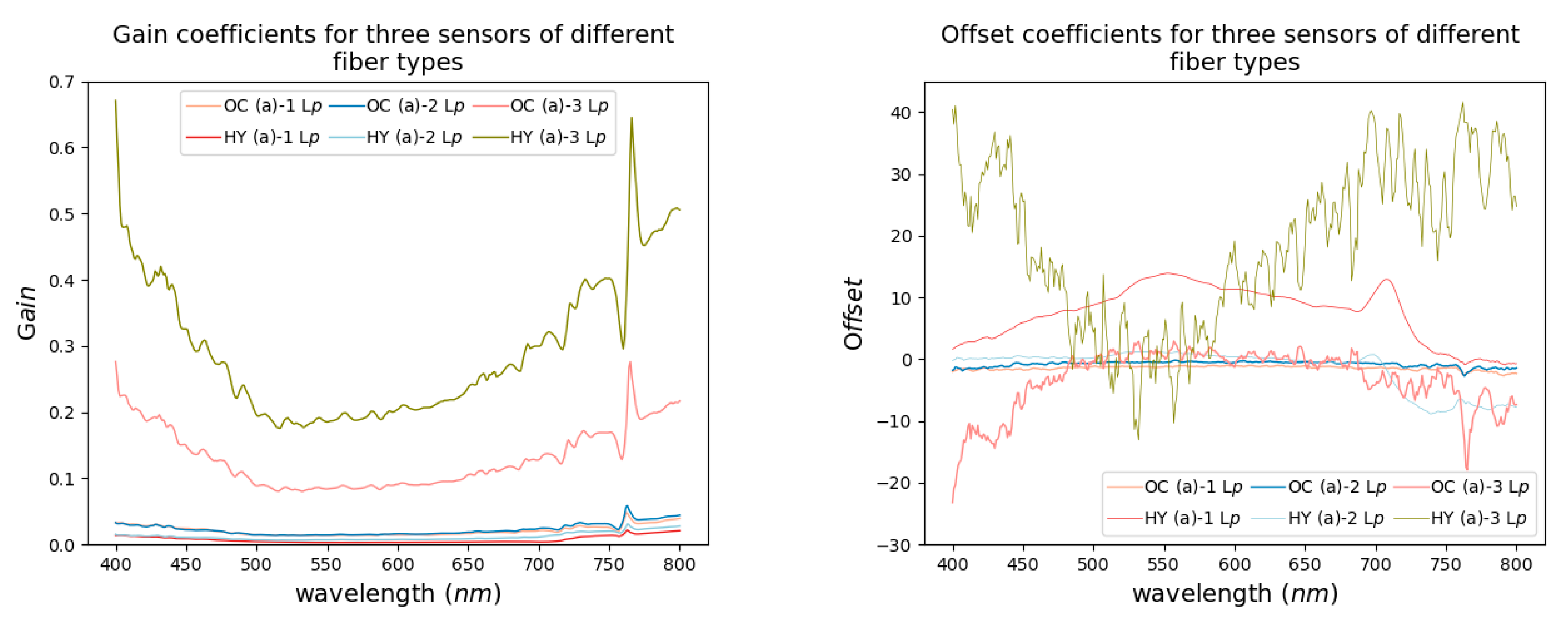
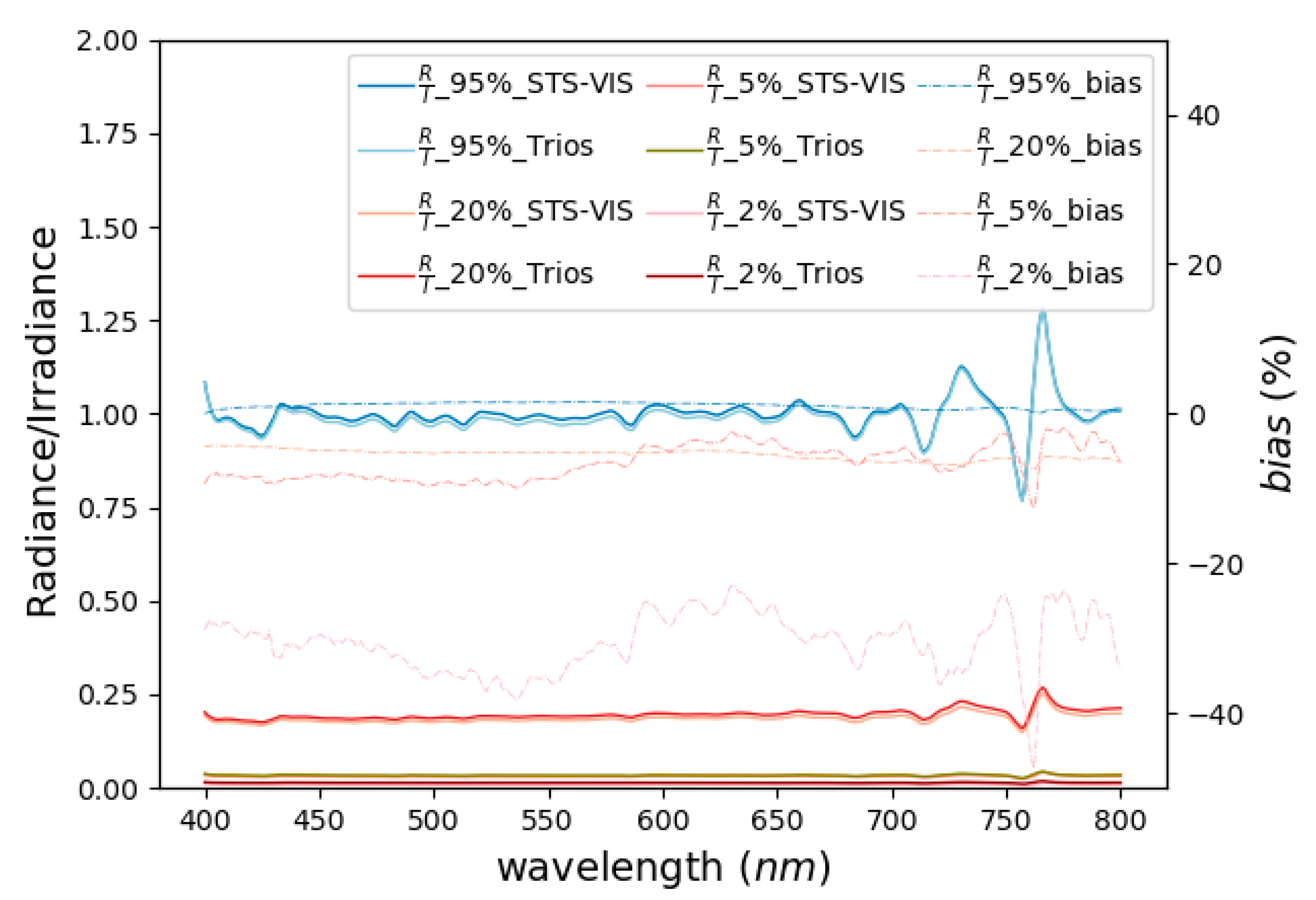


| Trios | STS-VIS | |
|---|---|---|
| Wavelength (nm) | 200–1100 | 350–810 |
| Optical Resolution (nm) | 3.3 nm | 2.2 nm |
| Ocean Optics (OC) | Hygirel (HY) | |
|---|---|---|
| Wavelength (nm) | 200–1100 | 200–1100 |
| Core Diameter (μm) | 600 | 1000 |
| Length (m) | 2 | 2 |
Disclaimer/Publisher’s Note: The statements, opinions and data contained in all publications are solely those of the individual author(s) and contributor(s) and not of MDPI and/or the editor(s). MDPI and/or the editor(s) disclaim responsibility for any injury to people or property resulting from any ideas, methods, instructions or products referred to in the content. |
© 2023 by the authors. Licensee MDPI, Basel, Switzerland. This article is an open access article distributed under the terms and conditions of the Creative Commons Attribution (CC BY) license (https://creativecommons.org/licenses/by/4.0/).
Share and Cite
Shi, J.; Shen, Q.; Yao, Y.; Zhang, F.; Li, J.; Wang, L. Field Radiometric Calibration of a Micro-Spectrometer Based on Remote Sensing of Plateau Inland Water Colors. Appl. Sci. 2023, 13, 2117. https://doi.org/10.3390/app13042117
Shi J, Shen Q, Yao Y, Zhang F, Li J, Wang L. Field Radiometric Calibration of a Micro-Spectrometer Based on Remote Sensing of Plateau Inland Water Colors. Applied Sciences. 2023; 13(4):2117. https://doi.org/10.3390/app13042117
Chicago/Turabian StyleShi, Jiarui, Qian Shen, Yue Yao, Fangfang Zhang, Junsheng Li, and Libing Wang. 2023. "Field Radiometric Calibration of a Micro-Spectrometer Based on Remote Sensing of Plateau Inland Water Colors" Applied Sciences 13, no. 4: 2117. https://doi.org/10.3390/app13042117
APA StyleShi, J., Shen, Q., Yao, Y., Zhang, F., Li, J., & Wang, L. (2023). Field Radiometric Calibration of a Micro-Spectrometer Based on Remote Sensing of Plateau Inland Water Colors. Applied Sciences, 13(4), 2117. https://doi.org/10.3390/app13042117






